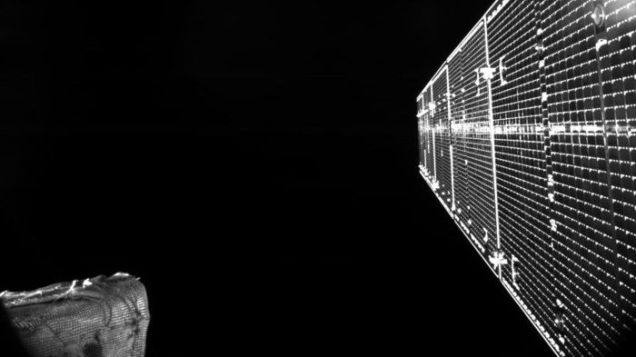
The BepiColombo Mercury Transfer Module (MTM), which is currently on an ambitious mission to the best planet with a payload of two orbiters, has sent us its first image from space.
The image was shared by the European Space Agency (ESA) this weekend and looks to be a bit of a selfie, capturing parts of BepiColombo before peering out into the dark abyss. Pictured are one of its extended solar arrays (there on the right) and the layered insulation of one of its sun sensors (on the left). The Ariane 5 rocket carrying BepiColombo successfully lifted off Saturday.
“The transfer module is equipped with three monitoring cameras, which provide black-and-white snapshots in 1024 x 1024 pixel resolution,” the ESA said. “The other two cameras will be activated tomorrow and are expected to capture images of the deployed medium- and high-gain antennas onboard the Mercury Planetary Orbiter (MPO).”
BepiColombo has a long journey ahead of it—seven years, to be exact. The joint mission between the ESA and the Japan Aerospace Exploration Agency (JAXA) hopes to learn more about one of the Solar System’s most perplexing planets with BepiColombo’s two orbiters, the Mercury Planetary Orbiter (MPO) and the Mercury Magnetospheric Orbiter (MMO). The MMO will study Mercury’s magnetic field and its interactions with the Sun, while the MPO will be charged primarily with mapping and imaging Mercury. The two spacecraft are carrying 16 instruments between them that will help with the mission’s science goals.
“It has a fantastic sequence of instruments on it,” Timothy Yeoman, professor of physics at the University of Leicester in the United Kingdom, told Gizmodo this week. “There’s no compromise in the design of the mission.”
The 1.3 billion-euro ($1.5 billion) mission is Europe’s first to the planet and will study Mercury’s magnetic environment, its formation, its interior and composition, and a whole lot more. Each orbiter is led by its respective agency and has its own unique primary goals while in orbit. Jan Wörner, the ESA’s director general, said in a statement that the “mission will return a huge bounty of science.”
BepiColombo’s lengthy journey will take it on a trajectory including “a fly-by of Earth, two of Venus and six of Mercury itself so it can slow down before arriving at its destination in December 2025,” the Associated Press reported on Saturday.
JAXA President Hiroshi Yamakawa said the agency had “high expectations” that data collected by the orbiters “will help us better understand the environment of the planet, and ultimately, the origin of the Solar System including that of Earth.”
Given that we’re only days into a seven-year journey, it’s probably safe to assume BepiColombo will be snapping plenty of exciting photos along its way.